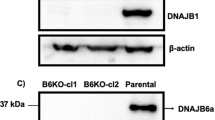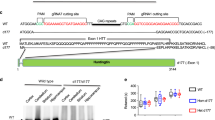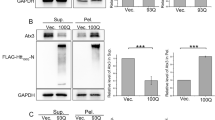Abstract
Protein misfolding is a common theme in neurodegenerative disorders including Huntington's disease (HD). The HD-causing mutant huntingtin protein (mHTT) has an expanded polyglutamine (polyQ) stretch that may adopt multiple conformations, and the most toxic of these is the one recognized by antibody 3B5H10. Here we show that the 3B5H10-recognized mHTT species has a slower degradation rate due to its resistance to selective autophagy in human cells and brains, revealing mechanisms of its higher toxicity.
This is a preview of subscription content, access via your institution
Access options
Access Nature and 54 other Nature Portfolio journals
Get Nature+, our best-value online-access subscription
$29.99 / 30 days
cancel any time
Subscribe to this journal
Receive 12 print issues and online access
$259.00 per year
only $21.58 per issue
Buy this article
- Purchase on Springer Link
- Instant access to full article PDF
Prices may be subject to local taxes which are calculated during checkout



Similar content being viewed by others
References
Gusella, J.F. & MacDonald, M.E. Nat. Rev. Neurosci. 1, 109–115 (2000).
Li, S.H. & Li, X.J. Trends Genet. 20, 146–154 (2004).
Shirasaki, D.I. et al. Neuron 75, 41–57 (2012).
The Huntington's Disease Collaborative Research Group. Cell 72, 971–983 (1993).
Miller, J. et al. Nat. Chem. Biol. 7, 925–934 (2011).
Peters-Libeu, C. et al. J. Mol. Biol. 421, 587–600 (2012).
Owens, G.E., New, D.M., West, A.P. Jr. & Bjorkman, P.J. J. Mol. Biol. 427, 2507–2519 (2015).
Klein, F.A. et al. Hum. Mol. Genet. 22, 4215–4223 (2013).
Bennett, M.J. et al. Proc. Natl. Acad. Sci. USA 99, 11634–11639 (2002).
Tsvetkov, A.S. et al. Nat. Chem. Biol. 9, 586–592 (2013).
Wu, P. et al. Acta Pharmacol. Sin. 37, 1307–1314 (2016).
Bennett, L.L., Ward, V.L. & Brockman, R.W. Biochim. Biophys. Acta 103, 478–485 (1965).
Ravikumar, B., Duden, R. & Rubinsztein, D.C. Hum. Mol. Genet. 11, 1107–1117 (2002).
Johansen, T. & Lamark, T. Autophagy 7, 279–296 (2011).
Filimonenko, M. et al. Mol. Cell 38, 265–279 (2010).
Pankiv, S. et al. J. Biol. Chem. 282, 24131–24145 (2007).
Kirkin, V. et al. Mol. Cell 33, 505–516 (2009).
Maruyama, Y. et al. Biochem. Biophys. Res. Commun. 446, 309–315 (2014).
Cui, X. et al. Sci. Rep. 4, 5601 (2014).
Kirkin, V., McEwan, D.G., Novak, I. & Dikic, I. Mol. Cell 34, 259–269 (2009).
Bjørkøy, G. et al. J. Cell Biol. 171, 603–614 (2005).
Legleiter, J. et al. J. Biol. Chem. 284, 21647–21658 (2009).
Hoop, C.L. et al. Biochemistry 53, 6653–6666 (2014).
Ehrnhoefer, D.E., Sutton, L. & Hayden, M.R. Neuroscientist 17, 475–492 (2011).
Atwal, R.S. et al. Nat. Chem. Biol. 7, 453–460 (2011).
Yao, Y. et al. eLife 4, e05449 (2015).
Dieterich, D.C., Link, A.J., Graumann, J., Tirrell, D.A. & Schuman, E.M. Proc. Natl. Acad. Sci. USA 103, 9482–9487 (2006).
Lu, B. et al. Nat. Neurosci. 16, 562–570 (2013).
Weiss, A. et al. Anal. Biochem. 395, 8–15 (2009).
Menalled, L.B., Sison, J.D., Dragatsis, I., Zeitlin, S. & Chesselet, M.F. J. Comp. Neurol. 465, 11–26 (2003).
Sapp, E. et al. J. Biol. Chem. 287, 13487–13499 (2012).
Aronin, N. et al. Neuron 15, 1193–1201 (1995).
Ko, J., Ou, S. & Patterson, P.H. Brain Res. Bull. 56, 319–329 (2001).
Acknowledgements
The authors wish to thank C. Lu (biostatistician) for the statistical analysis, L. Ma and S. Hexige at Fudan University for sharing some of the patient fibroblast lines, K. Kegel at MGH Harvard Medical School for cDNA plasmids, E. Sapp at MGH Harvard Medical School for lysate of the human post-mortem brain tissues, and the National Natural Science Foundation of China (31422024, 91649105, 31371421, 31601105) and the National Key Research and Development Program of China (2016YFC0905100) for funding.
Author information
Authors and Affiliations
Contributions
B.L. perceived the idea, initiated the project and designed the experiments. P.W., Y.F., Y.P. and X.S. performed the CH-chase experiments. Y.F. performed all the immunoprecipitation–western experiments with the help from others for blinding. H.Y. did the cell culture, molecular cloning and protein extraction. M.D. provided essential reagents and intellectual inputs.
Corresponding author
Ethics declarations
Competing interests
The authors declare no competing financial interests.
Supplementary information
Supplementary Text and Figures
Supplementary Results, Supplementary Table 1 and Supplementary Figures 1–10 (PDF 5350 kb)
Rights and permissions
About this article
Cite this article
Fu, Y., Wu, P., Pan, Y. et al. A toxic mutant huntingtin species is resistant to selective autophagy. Nat Chem Biol 13, 1152–1154 (2017). https://doi.org/10.1038/nchembio.2461
Received:
Accepted:
Published:
Issue Date:
DOI: https://doi.org/10.1038/nchembio.2461
This article is cited by
-
Inhibition of HIPK3 by AST487 Ameliorates Mutant HTT-Induced Neurotoxicity and Apoptosis via Enhanced Autophagy
Neuroscience Bulletin (2022)
-
Covalent targeting of the vacuolar H+-ATPase activates autophagy via mTORC1 inhibition
Nature Chemical Biology (2019)
-
Allele-selective lowering of mutant HTT protein by HTT–LC3 linker compounds
Nature (2019)
-
Proteostasis in Huntington's disease: disease mechanisms and therapeutic opportunities
Acta Pharmacologica Sinica (2018)
-
Mechanisms of protein toxicity in neurodegenerative diseases
Cellular and Molecular Life Sciences (2018)



